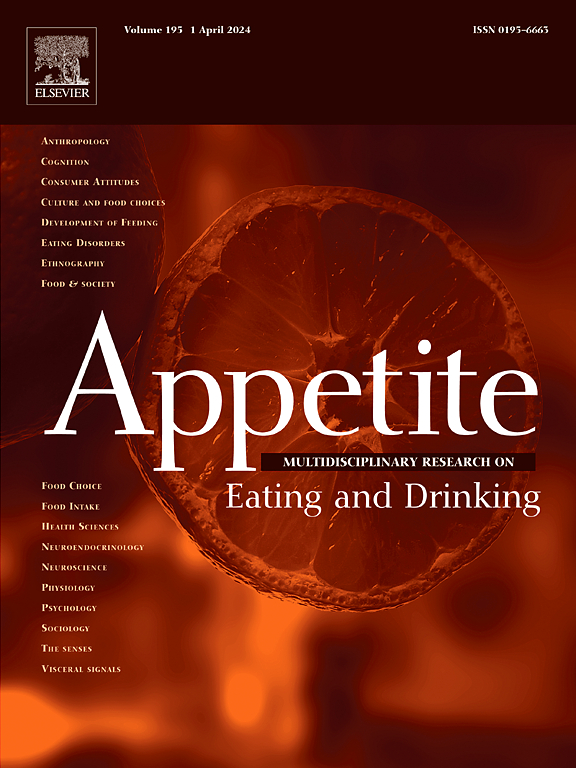Affect, interoception, and disordered and intuitive eating behaviors: Examining momentary mediational associations among women with eating disorder pathology
IF 3.8
2区 医学
Q1 BEHAVIORAL SCIENCES
引用次数: 0
Abstract
Objective
Affect and interoception (the ability to sense/connect with bodily sensations) are transdiagnostic self-regulatory factors that promote maladaptive eating behaviors at the between-person level (via cross-sectional research). However, no research has examined the mechanistic role of interoception dimensions in associations between affect, and disordered and intuitive eating behaviors (DEBs, IEBs) at the within-person level via ecological momentary assessment (EMA).
Method
The present study addressed this research gap by examining whether: (1) momentary interoception dimensions (“not distracting,” “self-regulation,” “body listening and trust”) differentially mediated momentary associations between negative and positive affect (predictors), and DEBs (dietary restriction, overeating, loss of control eating) and IEBs (“eating for physical versus emotional reasons,” “reliance on hunger and satiety cues,” “unconditional permission to eat,” “body-food choice congruence”) outcomes; (2) these associations varied across affect, interoception, and eating behavior types. Women (N = 150) with eating disorder pathology (Mage = 20.95, SD = 4.14) completed 4 EMA surveys on mobile devices daily for 10 days.
Results
Multilevel structural equation models showed that greater momentary negative affect was associated with more distracting from uncomfortable/painful bodily sensations at subsequent assessments (i.e., less “not distracting” interoception) and, in turn, less “eating for physical versus emotional reasons” IEB later that day. Greater momentary positive affect was associated with greater subsequent “body listening and trust” interoception and, subsequently, greater “reliance on hunger and satiety cues” IEB. No momentary indirect effects linking affect, interoception, and DEBs were significant.
Conclusions
These results may be leveraged to optimize eating disorders research and novel real-time interventions.
情感、内感受、紊乱和直觉性饮食行为:检查患有饮食失调病理的女性之间的瞬间中介关联。
目的:情感和内感受(感知/连接身体感觉的能力)是跨诊断的自我调节因素,在人与人之间的水平上促进不适应饮食行为(通过横断面研究)。然而,目前还没有研究通过生态瞬间评估(EMA)在个人层面上考察内感受维度在情感、紊乱和直觉饮食行为(DEBs, IEBs)之间的关联中的机制作用。方法:本研究通过检查是否解决了这一研究空白:(1)瞬时内感受维度(“不分散注意力”、“自我调节”、“身体倾听和信任”)在消极和积极情感(预测因子)、deb(饮食限制、暴饮暴食、饮食失控)和ieb(“因生理原因与情绪原因进食”、“依赖饥饿和饱腹感线索”、“无条件允许进食”、“身体-食物选择一致性”)结果之间的瞬时关联中起着差异介导作用;(2)这些关联在情感、内感受和饮食行为类型之间存在差异。患有饮食失调病理的女性(N = 150) (Mage = 20.95, SD = 4.14)每天在移动设备上完成4次EMA调查,持续10天。结果:多层次结构方程模型显示,在随后的评估中,更大的瞬间负面情绪与更多的不舒服/痛苦的身体感觉分散注意力有关(即,更少的“不分散注意力”的内感受),反过来,当天晚些时候“因为身体原因而不是情绪原因而吃东西”的IEB也更少。更大的瞬间积极影响与随后更大的“身体倾听和信任”内感受以及随后更大的“对饥饿和饱腹感线索的依赖”相关。情感、内感受和deb之间没有明显的瞬间间接影响。结论:这些结果可用于优化饮食失调研究和新的实时干预措施。
本文章由计算机程序翻译,如有差异,请以英文原文为准。
求助全文
约1分钟内获得全文
求助全文
来源期刊

Appetite
医学-行为科学
CiteScore
9.10
自引率
11.10%
发文量
566
审稿时长
13.4 weeks
期刊介绍:
Appetite is an international research journal specializing in cultural, social, psychological, sensory and physiological influences on the selection and intake of foods and drinks. It covers normal and disordered eating and drinking and welcomes studies of both human and non-human animal behaviour toward food. Appetite publishes research reports, reviews and commentaries. Thematic special issues appear regularly. From time to time the journal carries abstracts from professional meetings. Submissions to Appetite are expected to be based primarily on observations directly related to the selection and intake of foods and drinks; papers that are primarily focused on topics such as nutrition or obesity will not be considered unless they specifically make a novel scientific contribution to the understanding of appetite in line with the journal's aims and scope.
 求助内容:
求助内容: 应助结果提醒方式:
应助结果提醒方式:


